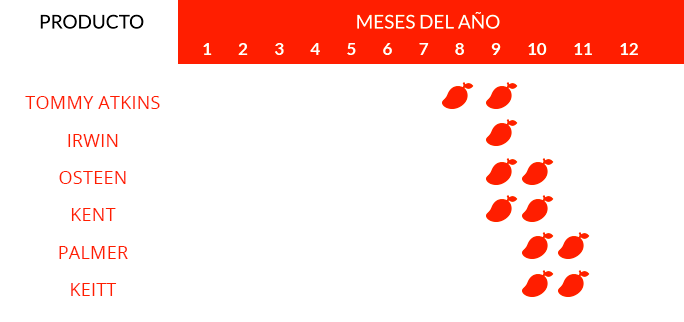TROPS mangoes
The most delicious on the market
At TROPS we are truly passionate about tropical fruits and understand the importance of care in every phase of the life cycle of the mango, from its cultivation all the way to the consumer’s table.
Our commitment as a business to bring the best mango to the market has led us to integrate the entire process of the life cycle of the mango within the company: cultivation, quality control and ripening on the tree, harvesting, handling and packaging, distribution and logistics. Only in this way can we guarantee the premium quality of our TROPS mangoes.
This 360-degree management of the mango allows us to bring to the market a high-quality product that is ready for consumption.
Production
The production area for our mangoes is concentrated in the region of Axarquía (Malaga) and Granada’s Costa Tropical.
The main varieties we produce are Osteen, Kent and Keitt, among others.
The harvesting season for our mangoes is concentrated between the months of September and November, depending on the variety.
Ripened on the tree
ALWAYS PERFECTLY RIPE
Our mangoes ripen on the tree. We do not manually harvest the fruit until it reaches the best moment for consumption. To do this, we monitor the sugar content in the fruit to ensure it is optimal to guarantee the best flavor.
After harvesting, our mangoes go through an exhaustive quality control process where, using the highest quality standards, they are classified according to their flavor, color and degree of ripeness and considering the size of the fruit according to consumer preferences.
TROPS mangoes maintain the natural wax they produce themselves and which protects them naturally.
We don’t wash them or artificially wax them, because we don’t need to! After all, we produce them ourselves.
Mango varieties
This is the main variety we produce. It is the richest variety in terms of flavor and aroma. It stands out for its red-purple skin. Its flavor is sweet with hints of acidity.
With less sweetness and aroma and a touch more acidity, its flesh is not fibrous. Its skin acquires pink and orange tones as it ripens.
Characterized by its intense sweetness, it has a very juicy flesh that is not fibrous. Its skin is orange-red in color.
Its flesh is excellent, very sweet, aromatic, soft and not fibrous. Its skin is red-yellow and it weighs around 300-400 g.
Long in shape, similar to the Osteen, its skin is purple in color. The flesh is firm, sweet and with slight hints of acidity.
Below is our production and consumption calendar:
PRODUCTION CALENDAR
Mango production is concentrated in the months from August to December. The best months for consumption are September, October and November.

The mango
HOW TO EAT IT
When choosing a ripe mango, choose one that is slightly soft when squeezed and that gives off a strong aroma. The color of the mango is not the best indicator of its ripeness, since some very good varieties stay green.
To speed up the ripening process, store the mango together with other different fruits, always at room temperature.
In the following video you can see how to cut and take full advantage of a mango.
Join TROPS, Europe’s leading producer of avocado and mango.
Find out here about the advantages of being a TROPS partner

